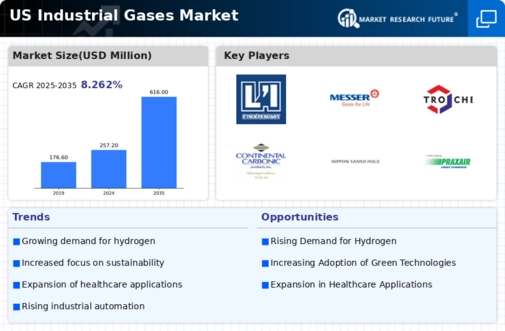The US Industrial Gases Market is characterized by its dynamic nature and competitive landscape driven by technological advancements, diverse applications, and shifting demand patterns across industries. Various factors influence the market, including industrial growth, environmental regulations, and the rising need for efficient production processes. Companies within this sector are striving to enhance their operational efficiencies and sustainability credentials while responding to evolving customer requirements. The marketplace is further influenced by strategic collaborations, mergers, and acquisitions, as firms seek to expand their geographic reach and technological capabilities.
As market leaders vie for a bigger share of the market, understanding their strengths, product offerings, and growth strategies becomes imperative for stakeholders including investors, customers, and policymakers.
Linde has established a significant presence in the US Industrial Gases Market, leveraging its extensive product portfolio and innovative technologies to meet the demands of various sectors such as healthcare, manufacturing, and food processing. The company emphasizes its commitment to quality and reliability, ensuring high standards for safety and performance across its offerings. Linde's established distribution networks and customer-centric approach enhance its ability to provide seamless supply chain solutions, which are vital in maintaining customer relationships and sustaining market leadership.
Their ongoing investment in R&D reflects their dedication to providing advanced gas technologies and applications, further solidifying their competitive edge in a rapidly evolving market landscape.
Messer Group has emerged as a notable player in the US Industrial Gases Market, providing a wide range of industrial gas solutions tailored to the needs of various sectors including metals, chemicals, and food and beverage industries. The company is recognized for its strong focus on customer service and tailored solutions that address specific industrial applications. Messer Group’s strengths lie in its commitment to sustainable practices and its ability to adapt to market trends through various strategic initiatives, including mergers and acquisitions that expand its operational footprint.
Their portfolio includes a diverse range of gases such as oxygen, nitrogen, and argon, which are critical in numerous industrial processes. By investing in expanding its production capabilities and infrastructure, Messer Group aims to enhance its market position while delivering value to its customers in the US industrial landscape.





















Leave a Comment